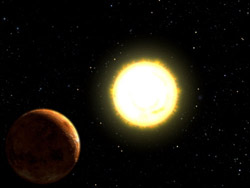WASHINGTON (Reuters) — An odd planet the size of Neptune, made mostly of hot, solid water, has been discovered not far from Earth and offers evidence that other planets may be covered with oceans, European astronomers reported Wednesday.

And many appear to be gas giants like Jupiter. This one appears to be smaller, but not small enough to have a rocky center as the Earth does.
“From the size and the mass we get the density,” Pont said. And the density of GJ 436b suggests it is made of water.
“We are not absolutely sure that it’s water, but with this kind of density and if you take the materials that usually make a planet, it is very typical of water planets,” Pont said.
The researchers wrote in their report: “The mass and radius that we measure for GJ 436b indicate that it is mainly composed of water ice. It is an ‘ice giant’ planet like Uranus and Neptune rather than a small-mass gas giant or a very heavy ‘super-Earth’.”
It is very close to its star, the M-dwarf star GJ 436. “It’s a small star, 100 times less bright than the sun,” Pont said. It is about half the sun’s mass.
“Smaller stars are cooler and redder,” he added.
That is why the water can persist, albeit in a hot and solid state. The astronomers estimate its temperature at 520 K, which is 250 degrees Celsius or 540 degrees F.
“It is by far the closest, smallest and least massive transiting planet detected so far,” the researchers, who included a team in Tel Aviv, Israel, wrote in their report published in the journal Astronomy & Astrophysics.
The star is relatively close in astronomical terms, about 33 light-years away. A light-year is the distance light travels in a year at 186,000 miles per second , or close to 6 trillion miles.
Just last month members of the same team said they had found the most Earth-like planet yet outside our solar system, with balmy temperatures and orbiting a red dwarf star called Gliese 581.
[Above image is a digital conceptualization of an exoplanet]

That is so strange, but so cool. What does hot ice act like anyways…?